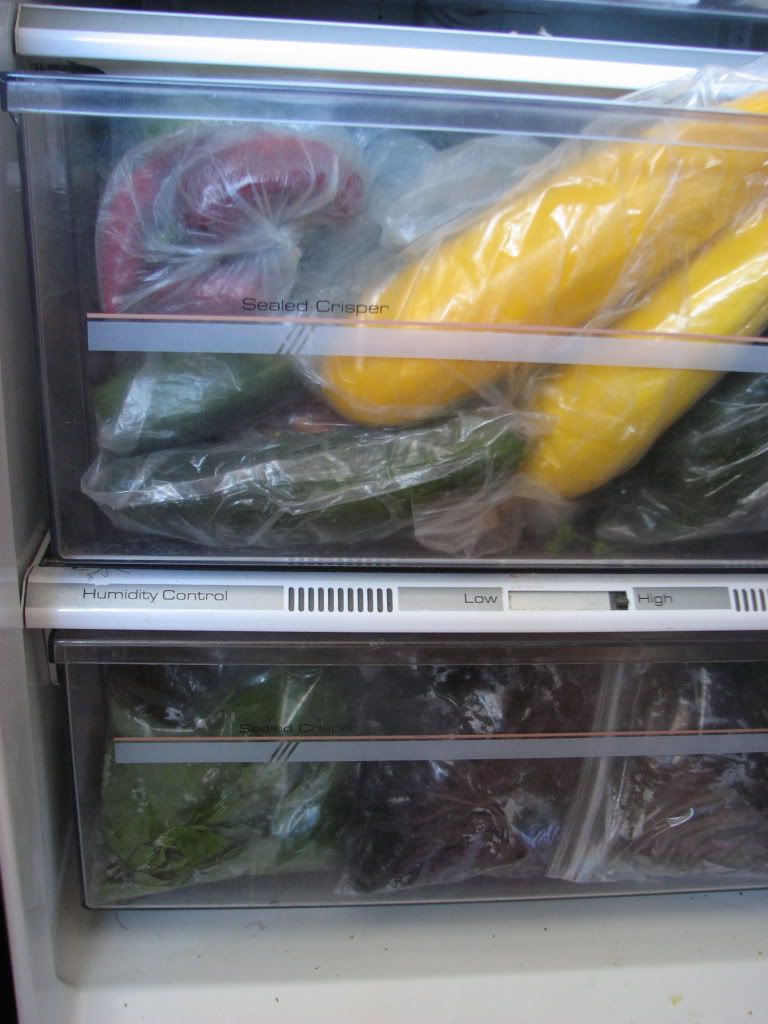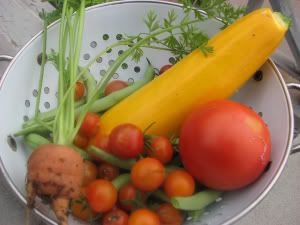They’re Not at Fault for Rotting in the Frig
‘Tis the season of vegetable abundance, and with it comes worry about refrigerator rot as we begin loading up (and over-loading ) on the fabulous produce coming to market. As some people joke, don’t let your produce become expensive compost.
Anytime I talk about buying and eating more vegetables, the subject of refrigerator rot surfaces. Seems there are a lot of dollars going down the garbage disposal, right along with the vegetables they bought.
While people always ask for tips on how to prevent this, one participant at a recent Whole Kitchen class worded the question in a way that got me stirred up. “How do I keep vegetables from going bad in my frig?” she asked.

The good side of me acknowledged this as a completely reasonable question and gave a considered response about the fundamentals of vegetable storage. Meanwhile, however, my devilish side was jockeying for a chance to mouth off: “What? Are vegetables supposed to last forever?” it fumed. ” They’re called ‘fresh’ for a reason! Maybe the problem isn’t that vegetables don’t last long enough. Maybe the problem is that people don’t eat them up fast enough!”
While I kept that inconsiderate imp in check at the time, I had to admit there was something to its rants. People faced with a case of vegetable rot are often taken aback. In a world where most foods have shelf lives measured in half-lives, it can seem surprising if not rude that vegetables would go bad on us. Surely there must be something wrong with the vegetables or the way they are packaged, right?
No, there is nothing wrong with the vegetables. They are living, breathing life forms, not processed and packaged products from factories. As life forms, they experience both a beginning and an end of life, and on the way to the end, they undergo a transformation from vibrant to rotted, just like all living things, including those on the top of the food chain. (More on this in tomorrow’s post.)
Which brings me back to the snippy conclusion reached by my devilish side : What if the problem isn’t with vegetables, but with vegetable buyers who neglect their veggies?”
Statistically, only one in ten of us come close to achieving the daily produce recommendations, and that’s only because potatoes are counted as a vegetable! So it’s not hard to imagine vegetables rotting in vegetable drawers due to simple neglect. That’s why my vegetable rot prevention advice begins here: Plan ahead.
- Plan Grab a piece of paper, sketch a rough weekly plan and then plop one (or two or three!) vegetables on each day. At a minimum, simply steam or saute them as side dishes. For more fun, weave them into pasta dishes, soups, salads or entrees. Either way, planning makes it 85% more likely that those vegetables will actually make their way out of the frig and onto your plate.
- Store Right With that said, we can move on to storage, which is also important. As a general rule, leave vegetables unwashed, place in loosely closed plastic bags and get them into the frig as soon as possible. For different vegetables, there are variations on this general rule which can be found in Vegetable a Month online magazine.
- Don’t Cave in to Throw Away Mentality After a few days in the frig, you might assume a vegetable is no longer fresh and must be pitched. Not so fast. It’s easy to get sucked into our “throw away” mentality, but vegetables last a lot longer than you’d think, especially when purchased very fresh (an automatic advantage of buying local.) Even though I routinely overbuy vegetables, I rarely pitch anything since they generally last a week to ten days.* With just a little planning, that’s plenty of time to use them all up.
- Stage Usage from Less to More Sturdy Improve your chances of success even more by planning to use the less sturdy vegetables in your crisper drawers (e.g., spinach, lettuce, zucchini, green beans and eggplant) before the sturdier ones (e.g., cabbage, broccoli, cauliflower and peppers.)
- Dig Deep for Vegetable Beauty Finally, even if a vegetable escapes notice until past its prime, no need to pitch it. Simply cut off any bad spots or pull away any wilted leaves and wash well. Taste to make sure the vegetable hasn’t gone bitter before adding to a dish. Cooking thoroughly can generally eliminate any possible contamination, but if you have any concern, go ahead and pitch a vegetable. Health and safety always trump vegetable conservation.
But what do I make with all those vegetables?  Lack of vegetable comfort may be the real culprit to blame for refrigerator rot. We tend to lack the basic vegetable knowledge that will have us reaching into the vegetable drawer each day with confidence. That’s where Vegetable A Month comes in. Each month, learn about a different, seasonal vegetable so you can weave it seamlessly into your everyday life–with all the good energy and wellness that comes with a vegetable rich diet.
Lack of vegetable comfort may be the real culprit to blame for refrigerator rot. We tend to lack the basic vegetable knowledge that will have us reaching into the vegetable drawer each day with confidence. That’s where Vegetable A Month comes in. Each month, learn about a different, seasonal vegetable so you can weave it seamlessly into your everyday life–with all the good energy and wellness that comes with a vegetable rich diet.
Tomorrow: More on vegetable storage. . .
1 thought on “Don’t Blame the Vegetables!”